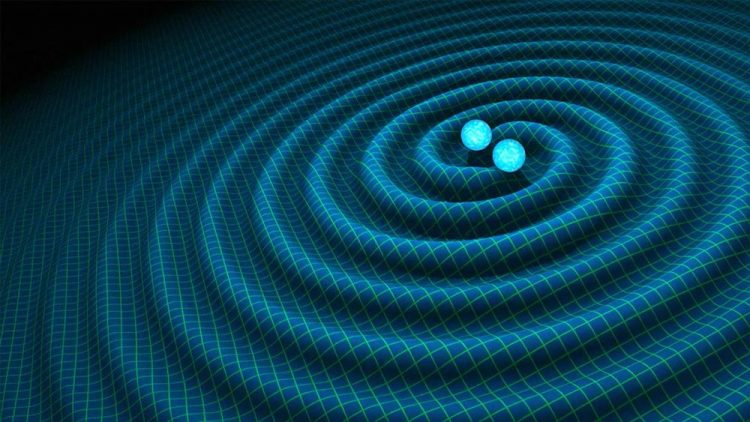Gravitational waves will settle cosmic conundrum

When neutron stars collide, they emit light and gravitational waves, as seen in this artist's illustration. By comparing the timing of the two emissions from many different neutron star mergers, researchers can measure how fast the universe is expanding. Credit: R. Hurt/Caltech-JPL
The cosmos has been expanding for 13.8 billion years. Its present rate of expansion, known as “the Hubble constant,” gives the time elapsed since the Big Bang.
However, the two best methods used to measure the Hubble constant have conflicting results, which suggests that our understanding of the structure and history of the universe–the “standard cosmological model”–may be incorrect.
The study, published today in Physical Review Letters, shows how new independent data from gravitational waves emitted by binary neutron stars called “standard sirens” will break the deadlock between the conflicting measurements once and for all.
“We've calculated that by observing 50 binary neutron stars over the next decade, we will have sufficient gravitational wave data to independently determine the best measurement of the Hubble constant,” said lead author Dr. Stephen Feeney of the Center for Computational Astrophysics at the Flatiron Institute in New York City. “We should be able to detect enough mergers to answer this question within five to 10 years.”
The Hubble constant, the product of work by Edwin Hubble and Georges Lemaître in the 1920s, is one of the most important numbers in cosmology. The constant “is essential for estimating the curvature of space and the age of the universe, as well as exploring its fate,” said study co-author UCL Professor of Physics & Astronomy Hiranya Peiris.
“We can measure the Hubble constant by using two methods–one observing Cepheid stars and supernovae in the local universe, and a second using measurements of cosmic background radiation from the early universe–but these methods don't give the same values, which means our standard cosmological model might be flawed.”
Feeney, Peiris and colleagues developed a universally applicable technique that calculates how gravitational wave data will resolve the issue.
Gravitational waves are emitted when binary neutron stars spiral toward each other before colliding in a bright flash of light that can be detected by telescopes. UCL researchers were involved in detecting the first light from a gravitational wave event in August 2017.
Binary neutron star events are rare, but they are invaluable in providing another route to track how the universe is expanding. The gravitational waves they emit cause ripples in space-time that can be detected by the Laser Interferometer Gravitational-Wave Observatory (LIGO) and the Virgo experiments, giving a precise measurement of the system's distance from Earth.
By additionally detecting the light from the accompanying explosion, astronomers can determine the system's velocity, and hence calculate the Hubble constant using Hubble's law.
For this study, the researchers modelled how many such observations would be needed to resolve the issue of measuring the Hubble constant accurately.
“This in turn will lead to the most accurate picture of how the universe is expanding and help us improve the standard cosmological model,” concluded Professor Peiris.
###
The study involved researchers from the Flatiron Institute (USA), UCL, Stockholm University, Radboud University (The Netherlands), Imperial College London, and the University of Chicago. UCL's contribution was generously funded by the European Research Council.
ABOUT THE FLATIRON INSTITUTE
The Flatiron Institute is the research division of the Simons Foundation. Its mission is to advance scientific research through computational methods, including data analysis, theory, modelling, and simulation. The institute's Center for Computational Astrophysics creates new computational frameworks that allow scientists to analyze big astronomical datasets and to understand complex, multi-scale physics in a cosmological context.
Media Contact
All latest news from the category: Physics and Astronomy
This area deals with the fundamental laws and building blocks of nature and how they interact, the properties and the behavior of matter, and research into space and time and their structures.
innovations-report provides in-depth reports and articles on subjects such as astrophysics, laser technologies, nuclear, quantum, particle and solid-state physics, nanotechnologies, planetary research and findings (Mars, Venus) and developments related to the Hubble Telescope.
Newest articles

NASA: Mystery of life’s handedness deepens
The mystery of why life uses molecules with specific orientations has deepened with a NASA-funded discovery that RNA — a key molecule thought to have potentially held the instructions for…

What are the effects of historic lithium mining on water quality?
Study reveals low levels of common contaminants but high levels of other elements in waters associated with an abandoned lithium mine. Lithium ore and mining waste from a historic lithium…

Quantum-inspired design boosts efficiency of heat-to-electricity conversion
Rice engineers take unconventional route to improving thermophotovoltaic systems. Researchers at Rice University have found a new way to improve a key element of thermophotovoltaic (TPV) systems, which convert heat…



